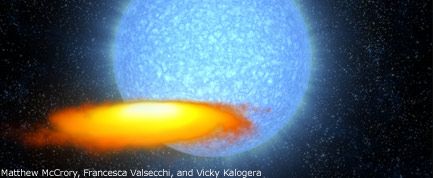
A massive black hole that is spewing X-rays and locked in a tight orbital dance around a huge, dim star finally has a good origins story.
Unlike binary set-ups that result when a giant star absorbs mass from a companion star that has nearly exhausted its nuclear fuel, the huge black hole M33 X-7 could have formed because, in this case, the companion still had plenty of hydrogen to burn, according to a new study.
The enormous stellar black hole has 15.7 times the mass of the sun and is orbiting an even larger star – which is 70 times the sun's mass – once every 3.45 days. Other X-ray binaries typically have stellar black holes of 10 solar masses.
The pair is located about 2.7 million light-years from Earth in the galaxy Messier 33.
Researchers had been hard-pressed to come up with a satisfying explanation for M33 X-7 using existing models of binary X-ray systems.
"This massive black hole is orbiting the most massive star ever discovered in this class of systems, and the orbit is very tight compared to the size of the star," study leader Francesca Valsecchi of Northwestern University told SPACE.com. [Gallery: Black holes of the universe]
As a further wrinkle, the companion star is much dimmer than usual for its mass.
Sign up for the Live Science daily newsletter now
Get the world’s most fascinating discoveries delivered straight to your inbox.
How can this exist?
In one model proposed to explain M33 X-7, after the primary star begins to run out of hydrogen fuel and expand, its outer region forms an envelope that encompassed both it and its companion.
But for a star big enough to generate a nearly 16 solar mass black hole, as in this case, the envelope would have led to the merger of the two stars.
While some other proposed models can account for the masses and tight orbit of the system, they don't solve the mystery of the black hole's X-ray glow and spin. The relative dimness of the black hole's star companion and their elliptical orbit also were unexplained.
Valsecchi and her colleagues came up with a different possible history for the pair.
Black hole's new origins story
In their model, the black hole-star pairing stems from a giant star – the future black hole – nearly 100 times the mass of our sun, circling a second star of about 30 solar masses every three days or so.
In such a tight orbit, the future black hole is able to start transferring mass while it is still burning hydrogen into helium. As a result, it loses most of its hydrogen envelope (becoming a so-called Wolf-Rayet star) and sheds the rest of the envelope in the form of stellar wind, exposing its helium core.
Its companion grows far more massive in the process, becoming the larger and more massive of the two stars. But it remains dim because the added mass doesn't dramatically change the rate of nuclear reactions in its core, researchers said.
Finally the progenitor star collapses under its own gravity, yielding a black hole, and begins absorbing stellar wind from its companion, leading to powerful X-ray emission. Energy released during the gravitational collapse imparts a kick to the black hole that leads to an elliptical orbit, and the black hole's spin results from the spin of the star itself.
"It is encouraging to have confirmation of our basic understanding of binary evolution and black hole formation," Valsecchi said, "as it allows us to trust our physical models and make predictions for other black hole systems that are yet to be discovered."
According to the researchers, existing Wolf-Rayet binaries containing massive companion stars may represent the early stages of process that led to M33 X-7, providing further evidence for the model.
Valsecchi said she and her colleagues are currently investigating the history of another X-ray binary system that contains the most massive black hole to have formed around another star.
- Gallery - Black Holes of the Universe
- Video Show: The Black Hole That Made You Possible
- Imitation Black Hole Seen On Earth
This article was provided by SPACE.com, a sister site of LiveScience.com.
Most Popular

